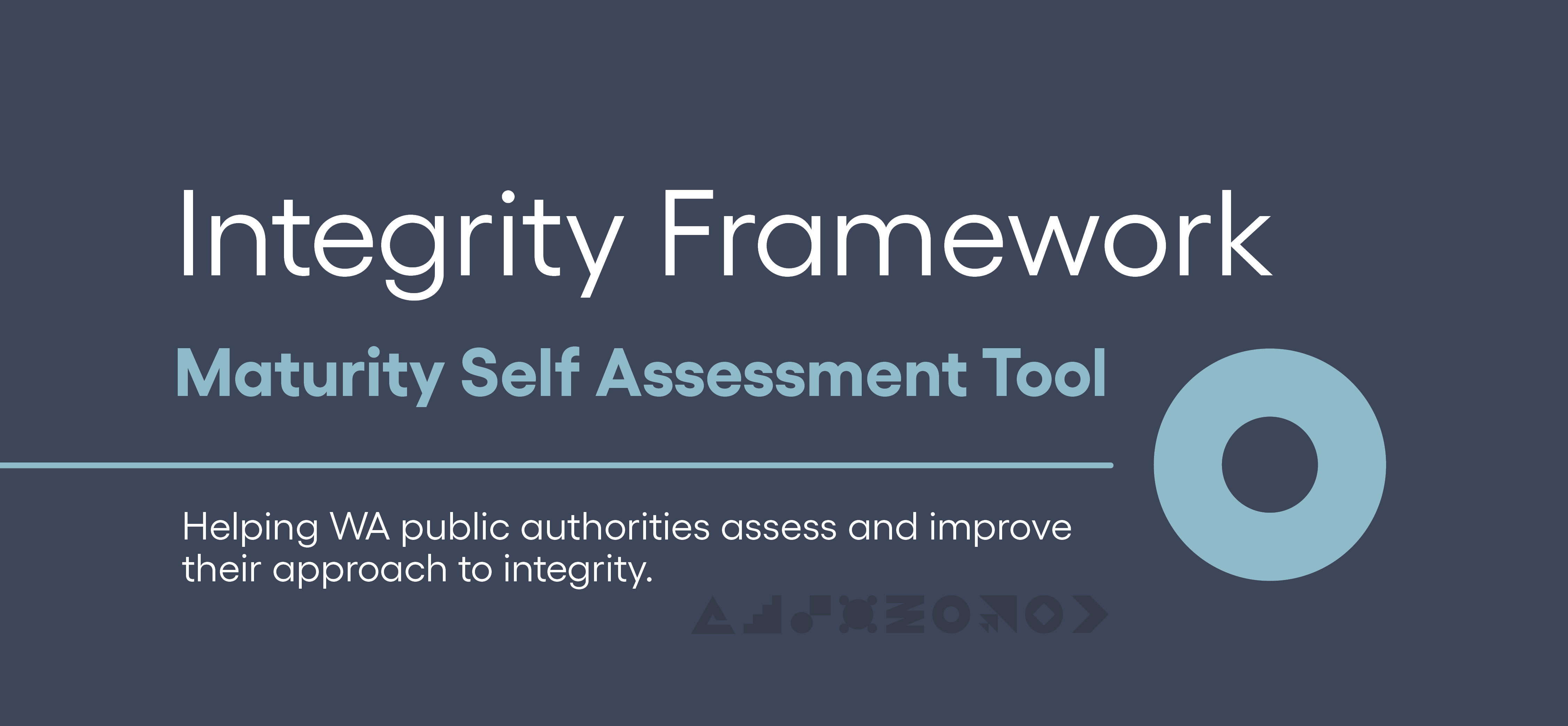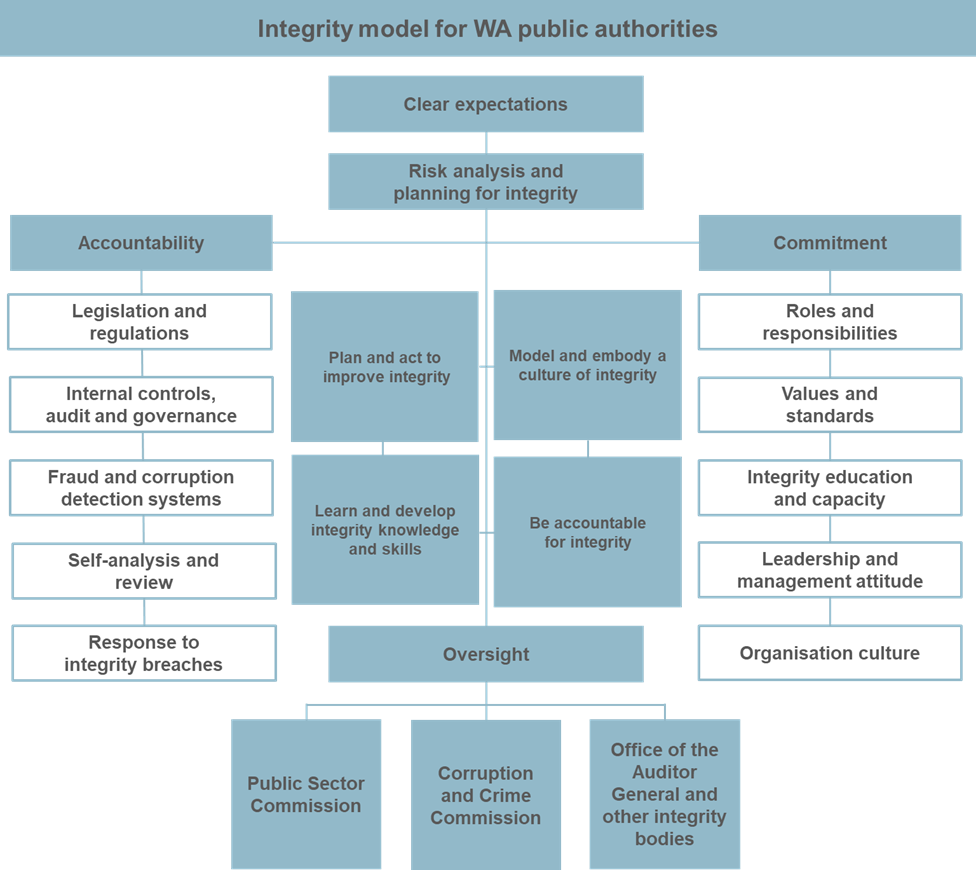The Integrity Framework Maturity Self Assessment Tool helps a public authority identify the strengths and weaknesses of its current approach to integrity in relation to 4 levels of maturity – emerging, developing, embedded and excelling – and develop a plan to reach its desired levels.
About the tool
Show moreThe tool is intended to help drive improvement across key elements that are the foundation for promoting integrity and preventing misconduct.
It is part of an integrated suite of resources that includes the Integrity Strategy for WA Public Authorities 2020-2023, and Integrity Framework Template and Guide. These should all be read together.
An integrity framework is an authority’s documented approach to integrity. The maturity of this approach can vary between authorities but even an authority without an integrity framework can still use the tool to assess its current state. The characteristics described help an authority to see where it can improve, including developing an integrity framework.
The tool is presented as a table comprising elements, maturity levels and their indicators and characteristics.
Elements
The 13 elements provide the foundation for preventing misconduct and corruption. They are from the integrity model in the Integrity Strategy and form the basis of the Integrity Framework Template and Guide.
Maturity levels and their indicators
The 4 levels of maturity – emerging, developing, embedded and excelling – are used to make an assessment of each of the 13 elements.
Each maturity level has 4 indicators that provide an overarching description of what the approach to integrity looks like at each level. Each level of maturity builds on the previous.
Characteristics
Characteristics are the types of actions and initiatives expected to be found at a particular level of maturity. A characteristic at one level builds on the previous. Where it does not, it should be assumed it is not occurring in the earlier maturity levels. These are not exhaustive.
Using the tool
Show moreIdeally, the tool will be used to assess the current state of integrity across the whole authority. A position or functional area responsible for integrity or governance coordinates the authority’s assessment with relevant internal stakeholders. In small authorities a member of the leadership group may conduct the assessment.
While assessing current maturity and setting desired maturity are important, they are not the tool’s main aim. Assessing on the left side of the tool should not be seen as negative. Rather, understanding and committing to the actions and initiatives needed to progress to the desired state is the main aim. It is a positive step to undertake an assessment and make a plan for improvement where necessary.
Step 1: Prepare to assess
Show more- Get support and approvals if necessary to do the self assessment.
- Identify individuals who can comment on each element (they should be easy to identify from an existing integrity framework).
- Plan how different views are to be managed and consensus reached.
Step 2: Assess current maturity
Show more- Assess each element by considering the maturity levels and their indicators and characteristics.
- Gather evidence (determined by the authority) to support that the characteristics are in place.
- Some example actions and initiatives are provided in the characteristics. These are not exhaustive and an authority may have others that demonstrate the characteristic is in place. For example when demonstrating ‘staff understanding/knowledge’, evidence can be found through actions and initiatives such as staff surveys, focus groups, interviews, staff performance processes and through relevant data sources.
- Documenting evidence to support the assessment explains reasons for choosing the maturity level and helps provide rigour to the process.
- Choose the maturity level that on balance best reflects the current approach to integrity for each element. Occasionally the pattern of ticks across an element may be spread out. In this case, use judgement to decide on the overall current maturity level based on the actions and initiatives in place. The maturity levels and their indicators might not describe the current approach perfectly and not all characteristics may be in place or need to be in place.
- Some elements may be assessed as being more mature than others. An authority rating consistently across all elements is unlikely.
Step 3. Set the desired maturity
Show more- Agree on the current maturity level for each element and then set the desired level if required.
- Reaching ‘Excelling’ may not be possible or even necessary.
- Record the reasons for decisions in the summary assessment and commentary sheet (or similar). This helps when undertaking the next self assessment.
Step 4. Develop a plan to improve
Show more- Develop a plan for improvement. The plan should:
- aim to implement as many of the characteristics as possible in the desired maturity level
- lift maturity over time in consideration of the authority’s operating context, risks and constraints
- include which improvements should be given priority, for example elements that are less mature or those that may present higher risks
- Identify who is responsible for each action.
- Share the assessment and improvement plan with the authority head, leadership group and other relevant stakeholders (audit committee or similar) for comment and endorsement. This provides an opportunity for the leadership group to explore how the assessment was determined.
- Implement the plan and monitor that improvements are made. This requires leadership support.
Step 5. Decide when to reassess
Show moreDecide when to undertake the next assessment. In determining the frequency of assessments consider:
- planned improvements
- the integrity framework’s review cycle.
Public sector bodies covered by Commissioner’s Instruction 40: Ethical Foundations must use the tool to reassess their approaches to integrity no less than every 3 years.




